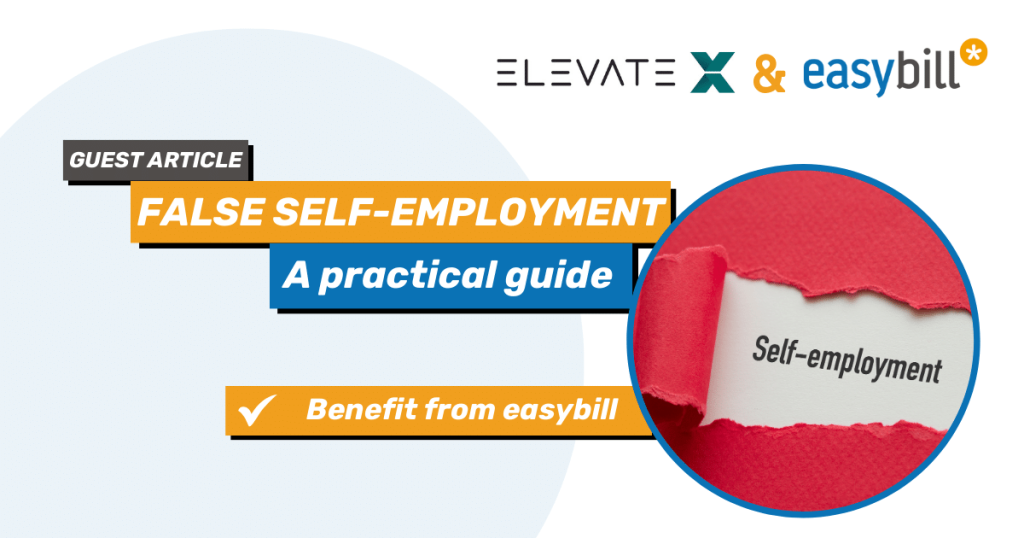
*Guest post: ElevateX Freelance Community
In the world of work, especially among freelancers and the companies that work with them, the topic of false self-employment is of great importance. This post summarizes the key aspects and recommendations from some of our previous articles to provide a clear, understandable and actionable overview. You can find more information on our website.
In the world of work, especially among freelancers and the companies that work with them, the topic of false self-employment is of great importance. This post summarizes the key aspects and recommendations from some of our previous articles to provide a clear, understandable and actionable overview. You can find more information on our website.
What is false self-employment?
Pseudo self-employment occurs when a person is formally considered self-employed, but the working conditions are more indicative of an employee relationship. This situation can have legal and financial consequences for both the employer and the employee, as the social security and tax obligations of an employee are circumvented. The core characteristics of bogus self-employment include dependence on a single client, a lack of entrepreneurial risk, predetermined working hours and integration into the client’s work organization.
work organization of the client. This constellation not only leads to potential additional claims for social security contributions and taxes, but can also transform the supposed self-employment into a legally recognized employment. It is therefore essential to clearly define and regularly review employment relationships in order to avoid the risks of false self-employment.
Who judges that?
A check for bogus self-employment can be initiated by various bodies, including the German Pension Insurance Association, labor courts, the tax office or social insurance providers. Both clients and contractors have the option of initiating such a check, for example in the context of disputes about protection against dismissal or contract termination. However, the initiative for an audit often comes from third parties, such as health insurance companies, who request an audit due to outstanding contributions.
Identifying features of false self-employment
In order to understand what needs to be considered when avoiding bogus self-employment, it is crucial to know the criteria by which authorities assess possible bogus self-employment. It is important to realize that the assessment is not always clear-cut; rather, each case is examined individually, with certain criteria and comparative cases being used to assess whether a company or freelancer could be affected by bogus self-employment.
The review includes an analysis of the contractual conditions as well as the actual employment relationships and conditions. It is necessary to provide evidence of bogus self-employment. The following points in particular are taken into account:
Regular employment of employees not subject to social security contributions
Although this is initially unproblematic in legal terms, companies that regularly employ such staff often have a higher number of cases of false self-employment.
Long-term contractual relationships
Freelancers often have contracts with a term of 3 to 24 months. Long-term contracts in particular attract the attention of the authorities, as this can result in financial benefits.
Dependence on a single client
This is particularly critical if the majority of sales are generated with just one customer. A strong dependency indicates a lack of independence.
Fixed working hours
Self-employed persons are primarily obliged to provide certain services without fixed working hours, apart from meeting certain deadlines.
Correspondence with work instructions
Self-employed persons are obliged to deliver a specific work without being subject to direct instructions.
Low hourly rates that do not cover the costs of a freelancer
A freelancer should receive an hourly rate that is higher than that of a permanent employee in order to cover their own costs such as pension provision.
Involvement in decision-making processes
A freelancer is primarily responsible for the completion of a work and should not be involved in or restricted by company-specific decisions
Prevention and best practices
In order to avoid false self-employment, companies and freelancers should pay attention to clear contractual relationships, the definition of work services instead of working hours and the diversification of clients. Open communication and an understanding of the legal framework are essential.
Whether you are a freelancer or self-employed entrepreneur
easybill is the invoice solution for all industries. Test now for 7 days free of charge!
Checklist: false self-employment yes or no?
- Does the contractor determine his own working hours?
- Do the tasks of the contractor differ from those of the permanent employees?
- Is the contractor free from controls by the client?
- Can the contractor determine his own place of work?
- Are hardware, software and premises separated?
- Is there a dependency on instructions between the contractor and the client?
- Does the contractor have freedom regarding the reporting of services?
- Does the way you work reflect your independence?
Consequences of false self-employment…
…for the client:
- Back payment of social security contributions and wage tax: Clients must pay social security contributions and wage tax retroactively for the entire duration of the collaboration.
- Legal obligations: The freelancer is treated as an employee, which entails protection against dismissal, vacation entitlement and continued payment of wages.
- Tax evasion: If intent is proven, the client may face legal consequences, including criminal prosecution.
- Liability and payment obligations: All liability and payment obligations apply retroactively as for regular employees, including the subsequent payment of social security contributions for up to four years.
- Fines and prison sentences: Deliberate bogus self-employment can result in fines, prison sentences and repayment demands for up to 30 years.
- VAT: The inclusion of VAT on invoices issued by the bogus self-employed person becomes invalid, which results in the inadmissible deduction of input tax and the repayment of input tax amounts.
…for the contractor:
- End of self-employment: The contractor’s self-employment ends and he retroactively becomes an employee with all the associated rights.
- Subsequent rights: The contractor receives protection against dismissal, vacation entitlement and continued payment of wages in the event of illness as well as net salary payments in the amount of the previous fee.
- Deregistration of the business: The business must be deregistered and membership of the Chamber of Industry and Commerce ends.
- Back payment of social security contributions: Both the client and the contractor are legally involved as joint and several debtors in the subsequent payment of social security contributions.
- Correction of invoices: Previously issued invoices must be corrected with regard to VAT. The input tax deduction is invalid and may have to be repaid.
Summary and outlook
Avoiding bogus self-employment requires attention and proactive action from both sides. Companies and freelancers should regularly inform themselves about current developments and adapt their employment relationships accordingly. Our checklist can serve as a practical tool to minimize risks and promote successful collaboration.
Author: ElevateX Freelance Community
Read also:
10 reasons to choose easybill and lexoffice as a combination of the two best #Backboneholders for your self-employment
easybill feature: document versioning for legally compliant action
How do I create a document in easybill? (german help center)


